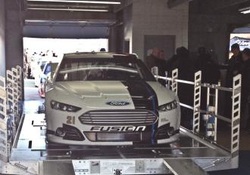
Now it’s time for a true short-track test for the car, which has new body styles specific for each manufacturer and new rear downforce and suspension configurations.
But this is Bristol, where the grinding of the top groove created a two-lane race last August where drivers raced in the middle and high lines.
That shouldn’t change with the new car.
“Of all the tracks we go to, Bristol will be the least different because it has the banking and aerodynamics are probably the least important,” Stewart-Haas Racing driver Ryan Newman said.
Bristol was known for hard, physical racing where drivers needed to bump each other out of the way, but a reconfiguration in 2007 that added progressive banking to the concrete oval never recreated that style.
Instead, drivers could pass with relative ease and even race in three different lanes.
So with lagging attendance, track officials took out some of the banking in the top groove and got the track and style of racing closer to normal, albeit unexpectedly with the lower groove rarely being used.
But this is Bristol, where the grinding of the top groove created a two-lane race last August where drivers raced in the middle and high lines.
That shouldn’t change with the new car.
“Of all the tracks we go to, Bristol will be the least different because it has the banking and aerodynamics are probably the least important,” Stewart-Haas Racing driver Ryan Newman said.
Bristol was known for hard, physical racing where drivers needed to bump each other out of the way, but a reconfiguration in 2007 that added progressive banking to the concrete oval never recreated that style.
Instead, drivers could pass with relative ease and even race in three different lanes.
So with lagging attendance, track officials took out some of the banking in the top groove and got the track and style of racing closer to normal, albeit unexpectedly with the lower groove rarely being used.



 RSS Feed
RSS Feed
